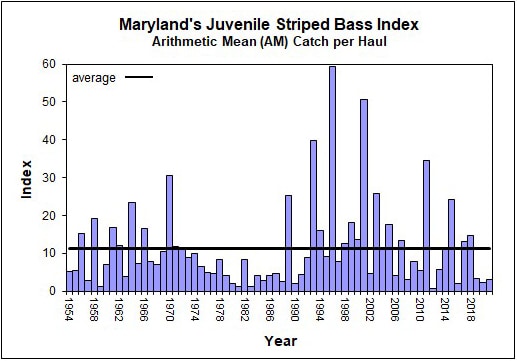
Continued poor juvenile index surveys, lack of management action create crisis
The recently released 2021 juvenile striped bass population survey in the Chesapeake Bay shows that for the third straight year, the Maryland Department of Natural Resources (DNR) has recorded startling low numbers. This marks the 11th time since 2005 that Maryland’s Young-of-the-Year index has failed to reach the long-term average. Biologists with the Virginia Institute Marine Science report that the 2021 index is slightly below that state’s long-term average.
The Young of the Year index is a crucial indicator of future striped bass health and sustainability, and the continued downward trends paint a grim future for the future of the fishery. While the exact causes of the negative recruitment trend likely include a combination of factors including water quality, reduced forage in Chesapeake Bay and warming ocean temperatures, lack of action by fisheries managers in response to the developing crisis is compounding the situation and jeopardizing the future of the fishery.

“It will be extremely difficult – if not impossible – to rebuild striped bass stocks without reducing fishing mortality and protecting spawning-sized fish, especially given the very troubling recruitment trends of the past few years,” said David Sikorski, executive director the Maryland Chapter of Coastal Conservation Association (CCA MD). “Unfortunately, we’ve heard the same excuses from Maryland DNR and others for far too long as they have chosen to dance around real and reliable conservation measures to limit fishing mortality in the Chesapeake Bay. Anglers are fed up, and want aggressive action, which includes investing in better state-based reporting systems to more accurately understand recreational angler impacts on stripers. The time is now to stop the harvest of large breeding female fish in all jurisdictions and limit our impacts on the juvenile stocks that are well below current abundance goals.”
Striped bass is the most popular recreational fishery in the country and has stood as one of the nation’s most successful conservation victories after rampant over-fishing and poor recruitment from the 1970s through the 1980s led to drastic management measures, including a five-year moratorium (1985-1990). The growing threat of returning to the darkest days of the fishery has frustrated recreational anglers who are demanding fisheries managers in the Chesapeake and along the East Coast take decisive steps immediately to head off another crisis. The Atlantic States Marine Fisheries Commission (ASMFC) is currently developing a striped bass management plan (draft Amendment 7) that will hopefully begin to rebuild the stock. However, that plan is not expected to be adopted until late 2022 although there is nothing preventing individual states with the foresight and political will from taking more conservative action now before the ASMFC mandate takes effect.
“The Chesapeake Bay produces 70 percent or more of the stripers on the East Coast, which means Bay jurisdictions must lead the way on striper conservation. These lackluster results are yet another stark reminder that fishery managers must do a better job of protecting large stripers that spawn in the Chesapeake each spring,” said Rob Allen, president of the CCA Northern Virginia Chapter. “Meaningful action includes cutting commercial harvest quotas and implementing strong, enforceable triggers linked to recruitment failure in the ASMFC’s Amendment 7. If not, recreational anglers in Chesapeake Bay and along this iconic gamefish’s range will not see an abundant fishery anytime soon, if at all.”
####

